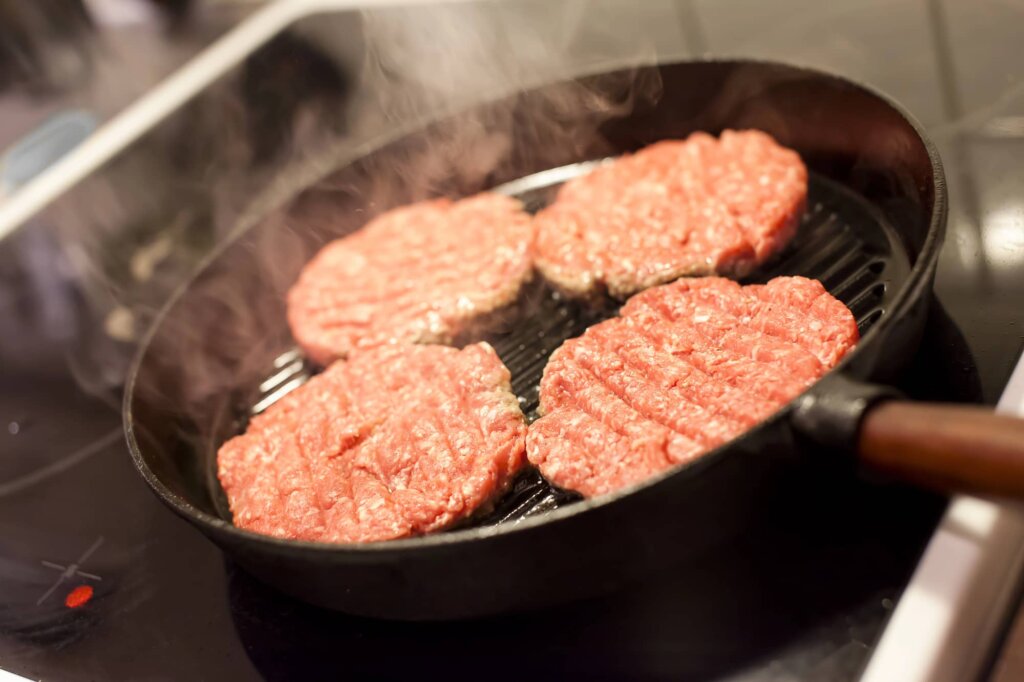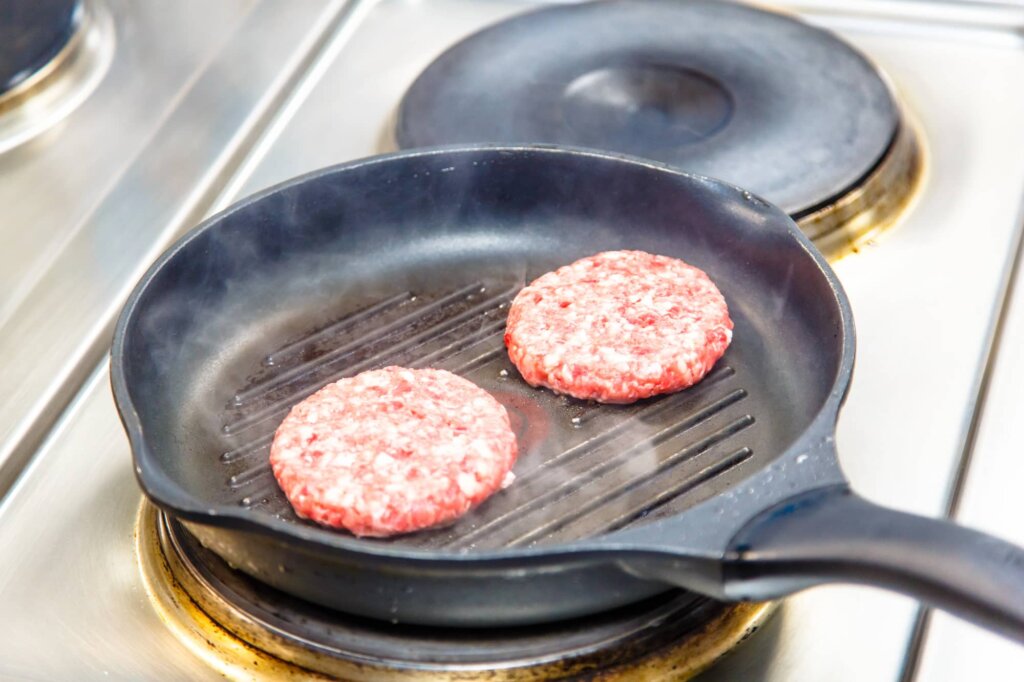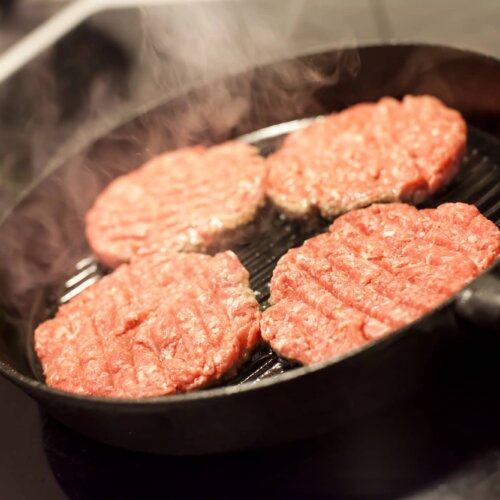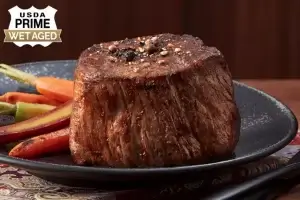
Burgers are a staple of the backyard barbecue, and they do indeed taste great when freshly off of your charcoal or propane grill. Yet sometimes it’s just not possible to fire up your full-sized grill and spend an hour or more in the backyard as you finish up dinner. The stovetop can produce flavorful burgers as well as your grill, and often the results are juicier than those that come from direct heat. It’s simply a matter of mastering a few small details to learn how to cook hamburgers on the stove that rival those from your favorite restaurants.
The Best Beef for Stovetop Burgers
Since you’ll be cooking these burgers in a pan, you can use a leaner ground meat mixture than you might use for those you would grill. The fat will all stay in the pan, helping add flavor and moisture to the meat. But you don’t want too much fat making it hard to get a good crust and sear on the surface of the patty. 85% and 90% lean ground beef both work well for this recipe. If you can, choose a ground steak mixture with a similar fat ratio for the best flavor. Ground chuck will work fine if that’s the only type of ground beef available.
If you have a meat grinder, you can buy some inexpensive steak and grind it yourself for burgers. Chill the meat and the grinder, stopping to chill both if you notice the fat getting warm and everything getting slippery. Grind some Sirloin or Skirt steak for optimal flavor with plenty of fat to balance out the lean meat.
How to Form the Burger Patties
The shape of the burger patty is essential to even cooking. When you take the ground meat and attempt to shape it exactly to the size and thickness you want, you’ll find the cooking process causes it to become thicker and smaller than you planned. This is due to the contraction of the meat proteins as they cook. To counter this effect, you want to create a shape that is thinner in the center than at the edges.
Make each patty about 25% wider than your buns, then press into the center until it’s about 1/4th of an inch lower than the edges of the patty. The center depression should cover 50% to 75% of the burger’s surface. You’ll find the patties are almost perfectly flat and even when cooked, giving you the juiciness you want without the risk of overcooking.
Tips for Cooking Perfect Stovetop Burgers

- Don’t overcrowd the burger patties in the pan. Give them an inch or more between each other so it’s easier to flip them and there’s less steaming between them to wash away flavor. If necessary, set up two cast iron pans to cook more burgers at the same time without crowding them.
- Get a wide and thin spatula, such as a fish spatula, to flip each patty without breaking it apart in the process. Wait to use the spatula until it’s time to flip since the meat won’t release from the pan until it’s cooked. Trying to loosen it early will only cause the meat to separate.
- Don’t flip the burgers too often. Give each side plenty of time to form a flavorful crust before flipping.
- Let the formed patties rest at room temperature for 10 minutes so they’re not cold when cooking. This ensures a better flavor and traps some of moisture inside the center for better results.
- Wait to season the meat until it’s on the stovetop. This ensures better bonding with the surface and a more even distribution of the salt and pepper.
- Make sure your pan is hot enough before adding each patty. The meat should sizzle immediately upon contact, but not pop too loudly or send up wisps of smoke. Let the pan rise in temperature a little each time you add a fresh batch of patties to compensate for the temperature of the meat.
- Handle the patties as little as possible, gently pressing the meat together while shaping but not patting or squeezing them too hard. This leads to a dense texture and slower cooking time and dries out the meat.
What Kind of Pan to Use
A heavy-bottomed cast iron pan is the best option because it provides a flavorful crust and transfers heat well without the need for a high heat setting. However, a non-stick or enamel pan will also work just fine if that’s what you have on hand. The key is to keep the pan greased with a small amount of oil first, then rely on the fat released by the burgers for further cooking.
Stainless steel pans tend to cause a lot of sticking and may require too much fat to release the burgers, leading to greasy or less flavorful results. You can use a cast iron grill pan if you prefer to let your burgers cook above the fat or really want the grill marks without having to cook outside in bad weather.
Should You Mix Anything Else Into the Beef?
It’s best to avoid mixing in eggs, bread crumbs, or other filler and binder ingredients. While they can add flavor and help stretch the meat, they also tend to produce a homemade burger that tastes more like meatloaf than a classic burger. All-beef burgers are best and they’re also easy to make. All you have to do is shape the patties using the above method and put them on a hot oiled pan, adding Kosher salt and pepper as you cook.
If you must, you can mix your seasonings like garlic powder, paprika, and thyme into the meat as you shape the patties. Avoid larger mix-ins like chopped onion, mushrooms, and peppers because these ingredients will steam as the meat cooks, adding too much moisture and leaving a crumbly or soggy burger.
Recipe Variations
Try applying a few splashes of soy sauce and sesame oil as the burgers reach the desired level of doneness for a depth of flavor that takes inspiration from Asian cuisines. Or use your favorite steak rub on the burgers in place of the salt and pepper sprinkled on the top. Brush on some barbecue sauce for flavorful and juicy burgers that will please the pickiest of eaters.
Burger Cooking Times
Burgers don’t take long to cook when they’re placed on a well-heated cast iron pan on a hot stove. There’s an informal rule that rare burgers take about 5 minutes to cook, medium burgers around 6 minutes, and well-done around 7 minutes.
Of course, this varies greatly depending on the size of the burger and the heat level you use. Instead of using these rough estimates, rely on an instant-read thermometer instead. Burgers must reach the following temperatures to get to the desired doneness level:
- Rare: 125 degrees F
- Medium Rare: 135 degrees F
- Medium: 145 degrees F
- Medium Well: 155 degrees F
- Well Done: 165 degrees F.
Stovetop Hamburger Recipe
Ingredients
- 1 lb of 85/15 or 90/10 ground chuck, or ground steak with a similar fat content
- 1 teaspoon of Kosher salt
- 1 teaspoon of cracked black pepper
- 4 buns
- 1 tablespoon of high heat oil
- Toppings like sliced cheese, lettuce, tomatoes, condiments (optional)
Instructions
1. Divide the meat into four equal portions. Shape the burger patties as thin or as thick as you like, then use your thumbs to press out the center so it’s about 1/4th of an inch lower than the edges.
2. Let the patties rest for about 10 minutes as you heat up the pan. Use a cast iron or non-stick pan over medium heat. Add the oil and heat it until shimmering.
3. Add just two patties at a time unless you have a very large pan with plenty of space for three or four. Cook the burgers without moving them too much, aiming for about 3 to 4 minutes of cooking before flipping. Sprinkle a pinch of salt and pepper on the raw side before flipping, then season the cooked side as well.
4. Continue cooking until the desired internal temperature. Serve immediately.
Conclusion
These homemade burgers on the stovetop will rival those from your favorite restaurants. Don’t forget great toppings like crispy bacon, your favorite cheeses, and caramelized onions for a touch of sweetness.

Stovetop Hamburgers
Ingredients
- 1 lb 85/15 or 90/10 ground chuck, or ground steak with a similar fat content
- 1 tsp Kosher salt
- 1 tsp cracked black pepper
- 4 buns
- 1 tbsp high heat oil
- toppings of choice, like sliced cheese, lettuce, tomatoes, condiments, etc. (optional)
Instructions
- Divide the meat into four equal portions. Shape the burger patties as thin or as thick as you like, then use your thumbs to press out the center so it’s about 1/4th of an inch lower than the edges.
- Let the patties rest for about 10 minutes as you heat up the pan. Use a cast iron or non-stick pan over medium heat. Add the oil and heat it until shimmering.
- Add just two patties at a time unless you have a very large pan with plenty of space for three or four. Cook the burgers without moving them too much, aiming for about 3 to 4 minutes of cooking before flipping. Sprinkle a pinch of salt and pepper on the raw side before flipping, then season the cooked side as well.
- Continue cooking until the desired internal temperature. Serve immediately.


